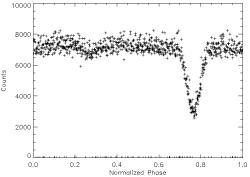Transiting Extrasolar Planets
|
Detecting an extrasolar planet by observing the periodic dips in a stars lightcurve enables us to extract a lot of information about the planet. We can determine the mass and radius of the planet easily, we automatically know the period and inclination of the orbit from the detection, and also with follow up spectroscopic observations it is possible to learn about the composition of the planets atmosphere, and therefore it's potential for harbouring life. At Birmingham we are currently using an instrument known as the Solar Mass Ejection Imager (SMEI) to monitor the entire sky for planetary transit events. The instrument is an all sky photometer that scans the sky using three cameras that have a combined field of view of 3° x 170°. The instrument is aboard the Coriolis spacecraft which is in a sun-synchronous polar orbit with an orbital period of 100 minutes. We are therefore able to produce long timescale lightcurves of tens of thousands of stars, and will be able to detect the signature of transiting Jupiter sized planets. Very precise photometry is required to detect the periodic dips in star lightcurves due to Jupiter sized planets as the planet only blocks out around 1% of the light from the star. Using algorithms based on a box-fitting method we are able to scan through the lightcurves quickly for these small changes and pick out the ones that exhibit any periodic features that could be caused by a planet. |
|
|
All current dedicated transit finding missions are ground based and are only currently sensitive to finding planets with orbital periods up to 10 days, but with the length of the SMEI mission, and constant coverage of stars for long periods of time uninterrupted we are able to probe for planets with much longer periods, i.e. up to 50 days or more. Work is at an early stage but so far we have been able to produce eclipsing binary lightcurves, and lightcurves of a number of bright stars to show the potential of the instrument. Two phase folded eclipsing binary lightcurves are shown below. The one on the left is of Lambda Tau, a 4th Magnitude eclipsing binary, and the one right is of Algol.
|




